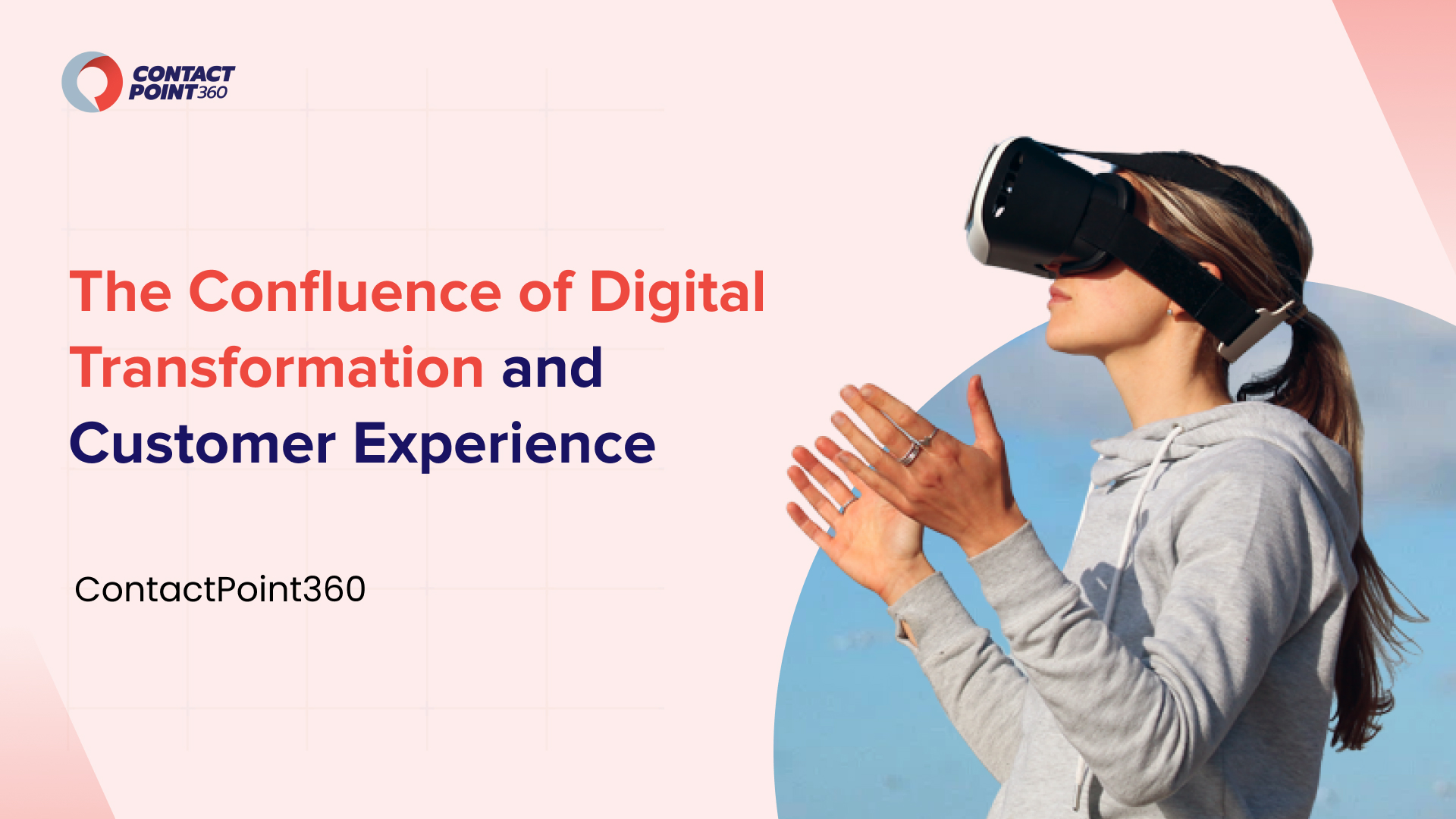Introduction
Let’s admit! To lead the league, businesses need a solid digital CX transformation strategy to create a predominant online presence. Failing which, survival could be challenging.
In fact, research reveals that 65% of customers expressed their app or website experience is “extremely important” to choose a brand. This underscores the need for a comprehensive digital transformation strategy that focuses on creating engaging, user-friendly digital experiences.
Today, simply launching a website is not good enough. You must craft an equally compelling, engaging, delightful and user-friendly digital transformation customer experience strategy.
The impact of digital transformation on customer experience is compelling businesses to create advanced business models that adapt to this newfound market. However, the most interesting part is that business is not driving the change – it is the customers.
Customers expect only relevant content related to what they are doing, what they want, and in what format they want. It is the digital transformation customer journey that dictates the strategy.
To stay always connected to your customers, businesses should include digital transformation in customer service to deliver unmatched experiences.
Luckily, the customer-first approach is already a part of the central strategy for many organizations. Research reveals that 35% of executives assert that digital transformation meets their customer expectations while improving overall operational efficiency. Likewise, 38% of business leaders plan to invest in technology to ensure it gives them a competitive advantage.

How Digital Transformation is Driving Customer Experience
Digital, as a word, was synonymously used for desktop websites. However, things are different now.
The use of mobile apps and tablet internet exceeded the use of desktop back in 2016. More and more consumers are turning to mobile phones to make quick product decisions. Consumers are also considering digital options for support, with mobile self-service and web support outranking over-the-phone customer support solutions.
In addition, an omnichannel CX approach is more important for CEM customer experience management programs. Customers are changing channels to get information, make purchase decisions, and find solutions to their problems. Brands must take proactive measures to eradicate internal silos and ensure cohesive and seamless customer experience across all channels.
Businesses that do not adapt to CX trends and fail to meet customer expectations could face massive annual losses. With more and more consumers adopting the cross-channel approach, it is important to streamline the end-to-end consumer journey, which is still not up to the mark.
Embrace the combination of digital transformation
and customer experience right here!
Comparing Digital Transformation Customer Experience vs. Customer Experience
Digital transformation customer experience is the key component of customer journey and experiences.
Customer experience (CX) is the impression your brand leaves on customers throughout the journey with a brand. It is a combination of interactions with people and products.
However, digital transformation customer experience is the technology arm of the customer experience management strategy of businesses. It involves the digital channels your customers use to engage with your products and people, and how they perceive the brand based on experience.
The difference between digital transformation CX and customer experience is as follows:
Digital CX vs. CX – The Key Differentiators
| Aspect | Digital Transformation Customer Experience | Customer Experience |
|---|---|---|
| Technology Integration | Fully leverages digital tools and tech | May not fully integrate technology |
| Data-Driven | Relies heavily on data analytics | Less reliant on data for insights |
| Channels | Multi-channel, including online platforms | Traditionally in-person or phone-based |
| Personalization | Highly personalized with AI and algorithms | Personalization may be manual or limited |
| Speed and Efficiency | Emphasizes speed and efficiency | May prioritize human interaction |
| Scalability | Easily scalable across large audiences | May be less scalable |
| Human Interaction | May include both human and AI interactions | Primarily human interactions |
| Adaptability | Adapts quickly to changing customer needs | May be slower to adapt |
| Customer Expectations | Sets high expectations for seamless experiences | Focuses on meeting customer needs |
| Competitive Advantage | Often seen as a competitive advantage | Often seen as a competitive advantage |
Digital Transformation Customer Experience Best Practices
Customer service digital transformation involves advanced tools and technologies to facilitate customers throughout their journey.
To make sure customers experience a seamless decision-making and purchase journey, consider these best practices for digital transformation of customer experience:
1. Add Artificial Intelligence
Artificial intelligence often takes us back to the sentient robots mimicking human actions. However, AI is not used the same way in modern companies. In fact, with the introduction of Natural Language Processing (NLP), AI has literally changed the concept of business and customer experience.
AI predominantly serves to automate business functions, alleviating the workload of employees. This not only saves countless hours but also allows for personalized customer experiences.
One area where AI has demonstrated remarkable efficacy in enhancing both customer and employee experiences is in email newsletters. Businesses can dispatch uniform messages to their entire customer base while maintaining a personal, authentic, and heartfelt tone. Achieving this without overburdening employees with the laborious task of customizing thousands of emails is made possible by AI. By extracting data from the CRM and personalizing each message with customer-specific information, AI creates emails that feel as though they were crafted expressly for each recipient.
2. The Surge in Chatbots
Chatbots are on the verge of a significant breakthrough in the retail sector across North America and Europe, thanks to the increasing accessibility of Natural Language Processing (NLP) for medium and small businesses, facilitated by ChatGPT.
Bots, however, were limited, only efficient in performing predetermined actions. This led to unengaging customer experiences and a lack of solutions.
On the brighter side, chatbots have improved with AI. Juniper research predicts that the global retail chatbot expenditure is likely to rise by up to 470% in another five years.
This trend will alleviate the pressure on the teams responsible for customer support, typically answering regular questions. Moreover, such automated systems can perform multiple routine operations like opening tickets, assigning them to the right agents, and getting faster resolution, thus creating seamless customer experience outsourcing solutions.
3. Improved Self-Service Capabilities
Customers prefer not to wait in queue for support. Understanding this, businesses have shifted focus to find better ways to help customers with self-service options. Besides chatbots, self-service digital transformation strategies include workflow automation and knowledge bases.
Workflow automation involves setting-up a process that operates by itself, which saves resources and time. For instance, when a customer places a return request, an auto generated email is sent to them for return instead of waiting for an agent.
Knowledgebases are searchable databases that allow customers to locate resources about products and/or FAQ answers. This creates a faster information-seeking process for customers that releases the burden on the support team.
4. Augmented Reality (AR) Tools
AR opens new avenues to improve digital transformation customer experience. By supplementing real images with advanced digital elements like text overlays or graphics, AR has changed the game. This is how digital transformation is driving customer experience across all industries.
AR is potentially useful for customer service as it can be used to supplement regular in-person experience. Using AR, you can display all product information when customers shop.
In addition, when customers visit the store with their smart devices, they can scan any product to see the data, including product information and customer reviews. This not only reduces friction, but also makes it convenient for customers to locate appropriate products or services.
5. Better Use of Predictive Analytics
Digital customer experience analytics help predict customer behaviors and refine marketing strategies. Business leaders can leverage these reports to understand their consumer behavior and the importance of the company’s role in their lives.
With rapid development of Machine Learning and AI, predictive analytics is all set to become an essential digital transformation customer experience tool for businesses.
6. Personalized Customer Experience Is the Key
Research shows that 70% of customers are willing to provide their personal data to be used for customer experience enhancement.
Personalized experiences are winning hearts across all demographics, ages, and other parameters. One of the best ways to personalize the experience is to send product recommendations to customers based on their recent purchase history or browsing history.
It conveys that the customer data you have retrieved is being used for specific purposes, making it more convenient to find what they are looking for.
As you gather more customer data, you can create better personalized customer experiences.
7. Privacy and Data Security Concerns
Customers are sharing their data, which adds to the responsibility of business to ensure privacy and security. Security compromises and data breaches are major factors for customers rejecting a brand. Adopting stringent privacy policies aligns with the principles of customer experience, creating safer engagements.
Update the latest privacy policies, regulations and laws affecting your business. Develop and maintain trust to build long-lasting relationships with your customers.
Get your personalized digital CX strategy from ContactPoint360
Last Word
Digital transformation is a battleground in the customer experience economy. There are significant opportunities for digital transformation customer experience strategies that delight. In the future, the ways to interact and engage with customers and the number of digital platforms will both increase to make customer experience digital transformation more critical for ongoing success. By analyzing both customer experience and operational data, companies can create effective, personalized CX transformation journeys that anticipate and resolve customer needs.
Through this transformation process, focus on customer experience data and operational data. Analyzing these crucial data sets will enable you to understand why customers engage with your brand and how they want to interact. Accordingly, you can create personalized digital transformation customer journeys and resolve any issues that may arise.
FAQs
What is digital transformation customer experience?
Digital transformation customer experience helps businesses streamline different processes to enhance customer engagement. Automating regular operational processes is the best example of digital transformation wherein businesses can deliver faster and efficient results. It also reduces queue times and enhances customer satisfaction.
What is the best example of digital transformation in customer service?
Digital transformation in customer service gives more choices to customers and makes their journey seamless and convenient. The best example is the use of Natural Language Processing (NLP) in IVRs that offers 24/7 support and AI-enabled chatbots.
What is the purpose of digital transformation in customer experience?
The aim of digital transformation in customer experience is to create seamless customer journeys throughout the buying process, deliver personalized experience, track customer engagement and interactions, and offer real-time feedback.























 United States
United States Canada
Canada Mexico
Mexico Colombia
Colombia Jamaica
Jamaica Philippines
Philippines India
India Egypt
Egypt




